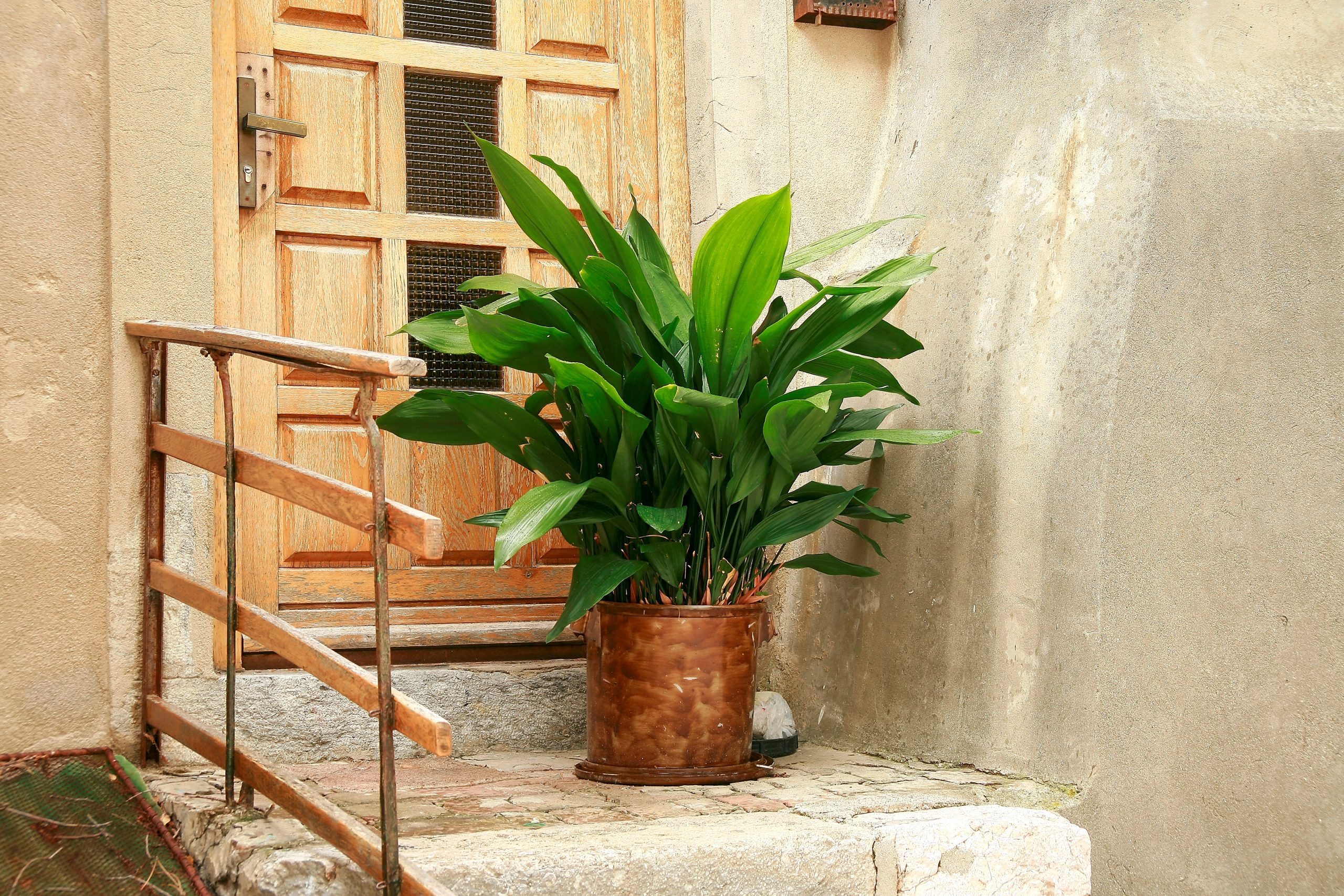Curious Questions: Will the aspidistra ever fly again?
The aspidistra was once the most popular of all houseplants in Britain, but these days they're barely seen. Why did that happen, asks Martin Fone, and can it make a comeback?


Look at a photograph of a Victorian family posing indoors and there is likely to be a large upright plant with leathery, lance-shaped leaves lurking in the frame. Its sculptural form enhanced the composition, but its presence was much a statement as an artistic prop. For the aspiring 19th century middle-classes owning an aspidistra was a sign of arrival, of success, of having enough disposable income to spend on home decorations. It was the must-have status symbol.
Even those down on their luck saw their aspidistra as the last vestige of their self-worth. Frank Owen, the starving carpenter in Robert Tressell’s The Ragged-Trousered Philanthropists (1914), was prepared to pawn everything other than his aspidistra.
By the time George Orwell was writing two decades later, things had soured and the plants were viewed with the sort of affection reserved these days for avocado bathroom suites. In Keep The Aspidistra Flying (1936) the plant of the title is a symbol of self-satisfied, middle-class British contentment with the status quo. Having an aspidistra is the antithesis of the revolutionary spirit, an ‘awful depressing thing’ and, according to Gordon Comstock — who attempts unsuccessfully to kill the mangy specimen in his rented room — ‘the first thing one buys after one’s marriage’.

At first blush, the aspidistra is a surprising choice of plant; it is neither elegant nor does it provide a beautiful display of flowers to merit its place in the living room. The clue to its popularity lies in Comstock’s doomed attempts to kill it; it was well-nigh indestructible, not for nothing dubbed as the cast-iron plant.
The Victorian drawing-room was not a particularly pleasant environment. Ill-fitting windows and doors made it draughty and the reliance upon a coal fire for heating meant that when it was not lit, room temperatures varied dramatically. Anxious to rid themselves of the gloom and smell of tallow candles, the middle classes eagerly embraced the latest advance in domestic illumination, gas lighting.
Gas lights, though, did not come without their disadvantages. They emitted toxic fumes which induced headaches and nausea, as well as blackening ceilings and flat surfaces with soot, discolouring curtains, and corroding metal. While most flowers and houseplants wilted, the aspidistra proved to be remarkably impervious to such noxious conditions.
It also proved adept at surviving studied neglect, capable of withstanding infrequent watering and low light, making it ideal for tucking in a corner of a room, as well as concerted attempts on its well-being. Known as the beer plant, publicans would tip the dregs of beer glasses into the pot of the aspidistra perched on the bar. Comstock even tried grinding hot cigarette-ends against its stem and mixing salt with its earth, only to find that the ‘beastly things are practically immortal’. Not quite, but the natural lifespan of an aspidistra is around fifty years.
Exquisite houses, the beauty of Nature, and how to get the most from your life, straight to your inbox.
"It is one of the best window plants, capable of resisting almost any hardships to which plants in such circumstances are subjected"
Native to south-eastern Asia, aspidistras are perennial herbaceous plants, belonging to the same family as the asparagus, and in the wild grow from rhizomes in shade under trees or shrubs. Their leaves, either solitary or grouped in small tufts of two to four, rise from the rhizome rather than growing on stems. Their flowers, often brown or maroon, follow suit, appearing either just above or slightly below ground, making them difficult to spot. Many an aspidistra has flowered unobserved by their owners.
There are around a hundred recognised species of aspidistra, the number having increased significantly once China opened up to visitors again in the 1980s, but the one most commonly gracing Victorian living rooms was Aspidistra elatior. Aspidistras only came to these shores in the early 19th century.
The hothouse at Colvin’s nursery in Chelsea was home to one of the earliest aspidistras to reach Britain, the informative Gardens Trust blog reveals. This ‘very curious’ and ‘previously unrecorded’ plant was named Aspidistra lurida or the ‘Dingy Flowered Aspidistra’ in John Bellenden Ker’s Botanical Register of 1822. Its provenance was a mystery; ‘of the place whence or the time when introduced nothing seems known that can be relied upon, nor have we met with any sample in either the Banksian or Lambertian herbariums (sic),’ he wrote. Within a year it was appearing in Loddiges’ catalogue of hothouse flowers.

In 1824 John Damper Parks presented the Horticultural Society with a new species, Aspidistra punctata, collected on his travels in China. It ‘first flowered in a bark-bed in February and March 1826’ in the Society’s gardens in Chiswick, its Transactions (1830) noted, describing it as ‘an obscure but curious stove-plant’.
While Parks had settled the question of the aspidistra’s origins, the mystery of how it was pollinated was not solved until 2017. Scientists from Kobe University revealed that the plant did not rely on visits from slugs as had previously been thought, but had evolved a clever strategy to attract fungus gnats. With its flowers appearing at ground level, often covered by leaf litter, and giving off a strong, musty, fungal odour, the fungus gnats are tricked into thinking it is a mushroom. They dive into the centre of the plant’s flowers, collect its pollen, and then transfer it to other plants as they fly on.
The aspidistra first became a popular houseplant in Paris, assuming ‘an important place in the decoration of apartments’, according to William Robinson’s Gleanings from French Gardens (1868). By 1873 the Gardeners’ Chronicle was proselytising the wonders of Aspidistra lurida, ‘one of the best window plants, capable, as it appears, of resisting almost any hardships to which plants in such circumstances are subjected…this plant and its variegated variety is grown largely in France and Belgium in windows, corridors etc, and might with advantage be more often employed here for like purposes’.
The seeds sown by the Chronicle’s writer bore fruit and what was good enough for the Parisian bourgeoisie soon became an object of desire for the aspiring British middle-classes, its hardiness and undemanding nature appealing to those with only the slightest tinge of green on the end of their fingers. However, this was to prove the Aspidistra’s undoing.
So ubiquitous, so hardy and so long-lived was it that what had once been an object of pride after several decades was now looking past its best, often handed down the generations, and gradually shunted from the drawing room to ‘the whatnot, near the ‘atstand in the ‘all‘. During the interwar years it had become a music hall joke, and by the 1950s, with the boom in housebuilding and the rise in home ownership, the aspidistra’s presence jarred with the yearning to create a brighter, modernist future. It was supplanted in our affections by the yucca, also a member of the asparagus family, cacti, and rubber plants.
Nevertheless, the aspidistra owner’s dilemma over what to do with their plants lingered well into the 1970s. In July 1973 the BBC’s Nationwide programme ran a story on the quest of Putney resident, Mrs Arnold, for a new home for her unwanted but well-cared for seventy-year-old aspidistra. Salvation came in the form of the hothouse at Syon Park. Not all aspidistras were so lucky.
Houseplants are once more on trend, Britons spending more than £300 a year on them and 35% of us purchasing at least one in 2021. While valued for improving our wellbeing, they can be angst-inducing, with 48% of twenty-five to 39-year-olds worried about keeping them alive.
The solution is obvious; cue the low maintenance, almost indestructible aspidistra. It might be flying once more.

Credit: Rex
Curious Questions: Why do we still use the QWERTY keyboard?
The strange layout of keyboards in the Anglophone world is as bafflingly illogical. Martin Fone, author of 'Fifty Curious Questions',

Curious Questions: How did one of the world's great biscuits get named after a freedom fighter named Garibaldi?
Martin Fone delves into the curious history of the garibaldi biscuit — and how it's linked to the tale of Italian

Curious Questions: Why do we talk about the '$64,000 question' — even in a country where we don't use dollars?
A question about a question? Absolutely. Martin Fone gets to the bottom of where this curious phrase originates — and how

Credit: Alamy
Curious Questions: Why does freshly-mown grass smell so good?
Nothing says 'Spring is here' better than that wonderful aroma of newly-cut lawn. Martin Fone, author of 'Fifty Curious Questions',

Curious Questions: Why do the British drive on the left?
The rest of Europe drives on the right, so why do the British drive on the left? Martin Fone, author

Curious Questions: Do you get wetter running or walking in the rain?
Does running in the rain get you out of it quicker? Or do you just run into more water more
After graduating in Classics from Trinity College Cambridge and a 38 year career in the financial services sector in the City of London, Martin Fone started blogging and writing on a freelance basis as he slipped into retirement. He has developed a fearless passion for investigating the quirks and oddities of life and discovering the answers to questions most of us never even think to ask. A voracious reader, a keen but distinctly amateur gardener, and a gin enthusiast, Martin lives with his wife in Surrey. He has written five books, the latest of which is More Curious Questions.
